 W
WAkinoshima Katsumi is a former sumo wrestler from Akitsu, Hiroshima Prefecture, Japan. He made his professional debut in 1982, and after reaching the top division in 1988 he remained there for 15 years. His highest rank was sekiwake. He was known as the "giant killer" having defeated more yokozuna than any other untitled wrestler (maegashira) in the history of sumo, earning himself 16 gold stars or kinboshi over his career, four more than his nearest kinboshi earning rivals, Takamiyama and Tochinonada. He also has received 19 performance prizes (sanshō), another record in sumo history.
 W
WAminishiki Ryūji is a retired Japanese sumo wrestler. He made his professional debut in 1997 and reached the top makuuchi division in 2000. He earned twelve special prizes and won eight kinboshi or gold stars for defeating yokozuna. He was twice runner-up in a tournament. The highest rank he reached was sekiwake. After more than 22 years as an active wrestler he retired in July 2019 at the age of 40. He is in the all-time top ten for a number of sumo records, including most career wins, most top division appearances and most tournaments ranked in the top division. He wrestled for Isegahama stable.
 W
WAoiyama Kōsuke is a Bulgarian professional sumo wrestler or rikishi from Elhovo. He made his professional debut in 2009, reaching the top division two years later, debuting in the November 2011 tournament. He has won four Fighting Spirit awards, one Technique award and one kinboshi for defeating a yokozuna. He has twice been runner-up in a tournament. His highest rank has been sekiwake. He is one of the heaviest competitors in sumo, weighing around 200 kg for most tournaments.
 W
WAran Hakutora is a Russian former sumo wrestler. He began his professional career in January 2007 and made the top division in a record eleven tournaments. The highest rank he reached was sekiwake. He was runner-up in consecutive tournaments in May and July 2010 and earned two sanshō or special prizes for Fighting Spirit. He wrestled for Mihogaseki stable.
 W
WArase Nagahide , real name Arase Hideo was a sumo wrestler from Ino, Agawa District, Kōchi Prefecture, Japan. His highest rank was sekiwake. After his retirement in 1981 he became a television personality and ran unsuccessfully for political office.
 W
WAsasekiryū Tarō is a former sumo wrestler. He made his debut in January 2000, reaching the top makuuchi division in March 2003. He won four special prizes, and spent a total of five tournaments in the titled san'yaku ranks. The highest rank was sekiwake. He was a runner-up in two tournaments in 2004 and 2007. After 2013 he was mainly ranked in the lower jūryō and makushita divisions. He acquired Japanese citizenship in April 2017 and retired from active competition the following month. He became a coach at Takasago stable under the elder name Nishikijima Oyakata. In November 2020 he became head coach of Takasago stable.
 W
WDaieishō Hayato is a Japanese professional sumo wrestler. He began his professional career in 2012 at the age of eighteen and reached the top makuuchi division in September 2015. His highest rank to date has been sekiwake. He has three gold stars for defeating yokozuna, four special prize for Outstanding Performance and one special prize for Technique. He wrestles for the Oitekaze stable. In January 2021 he became the first wrestler from Saitama Prefecture to win the top-division championship.
 W
WDewanishiki Tadao was a sumo wrestler from Tokyo, Japan. His highest rank was sekiwake. He won ten kinboshi or gold stars for defeating yokozuna during his long top division career, which only four wrestlers have bettered. He also won four special prizes. After his retirement he was a coach at Dewanoumi stable.
 W
WFusanishiki Katsuhiko was a sumo wrestler from Ichikawa, Chiba, Japan. He made his professional debut in January 1952 and reached the top division in May 1957. His highest rank was sekiwake. Upon retirement from active competition, he became an elder in the Japan Sumo Association. He married the daughter of his stable master, ex-maegashira Shachinosato. He was head coach at Wakamatsu stable from 1979 until 1990, when he left the Sumo Association because of poor health. Former ōzeki Asashio Tarō IV took over as Wakamatsu's head coach in March 1990.
 W
WHokutōriki Hideki is a former sumo wrestler, from Tochigi, Japan. He reached the top makuuchi division in 2002 and was runner-up in three tournaments. He had four special prizes in his career and a gold star for defeating yokozuna. The highest rank he reached was sekiwake. He retired in May 2011 and is an elder of the Japan Sumo Association and a coach at Kokonoe stable.
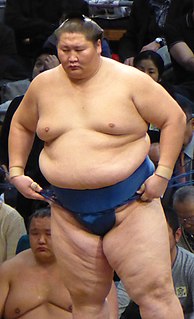 W
WIchinojō Takashi is a Mongolian professional sumo wrestler from Arkhangai. He is notable as being the second foreign-born wrestler, and the first of non-Japanese descent allowed to debut at an elevated rank in the third makushita division due to his amateur sumo success. In only his third professional tournament he took the second division jūryō championship. In his fifth professional tournament, his first in the top makuuchi division, he was the runner-up and promoted all the way to sekiwake, his highest rank to date. He was one of the heaviest rikishi in the top division as of September 2020.
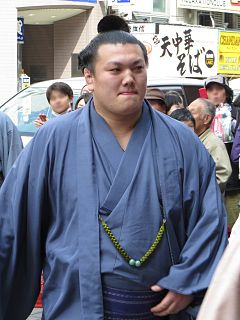 W
WIkioi Shōta is a Japanese former professional sumo wrestler from Katano, Osaka. He began his career in March 2005. He won the jūryō championship in November 2011 in his very first tournament in the division and just two tournaments later made his makuuchi division debut. He was runner up to Jōkōryū in the jūryō division in September 2012. His highest rank was sekiwake. He won four special prizes for Fighting Spirit and five gold stars for defeating yokozuna. He did not miss a single bout from his professional debut until the last day of the January 2021 tournament. He retired in June 2021 to become a coach and elder of the Japan Sumo Association under the name Kasugayama.
 W
WIwakaze Kakutaro was a sumo wrestler from Tokyo, Japan. He made his professional debut in May 1952 and reached the top division in May 1956. His highest rank was sekiwake. He retired from active competition in September 1965.
 W
WKaisei Ichirō is a third generation Japanese Brazilian professional sumo wrestler (rikishi) from São Paulo, Brazil. Making his debut in September 2006, he reached the top makuuchi division in May 2011. His highest rank has been sekiwake. He has been runner-up twice, once in the July 2013 tournament and another in the March 2018 tournament. He has received three Fighting Spirit prizes to date.
 W
WKamikaze Shoichi was a sumo wrestler from Higashikagawa, Kagawa Prefecture, Japan. He made his professional debut in May 1937 and reached the top division in May 1942. His highest rank was sekiwake. He won six gold stars against grand champion yokozuna in the course of his career. Upon retirement from active competition he became an elder in the Japan Sumo Association under the name Kataonami. He left the Sumo Association in September 1952.
 W
WKitanonada Noboru, born Noboru Ogata, was a sumo wrestler from Abashiri, Hokkaido, Japan. His highest rank was sekiwake. He was ranked in the top makuuchi division from 1950 until 1962 and earned ten gold stars for defeating yokozuna. After his retirement from active competition he was an elder of the Japan Sumo Association and worked as a coach at Tatsunami stable until his mandatory retirement in 1988 upon reaching 65 years of age. He then became a sumo TV commentator.
 W
WKitaseumi Hiromitsu is a former sumo wrestler from Kitahiyama, Hokkaidō, Japan. He made his professional debut in July 1964, and reached the top division in March 1972. His highest rank was sekiwake. He retired in May 1979 and was active elder in the Japan Sumo Association under the name Kimigahama. As Kimigahama-oyakata he first coached at Kokonoe stable, but moved to Hakkaku stable when it was started up by former Kokonoe wrestler Hokutoumi in 1993. He reached the Sumo Association's mandatory retirement age of 65 in July 2013. The Kimigahama toshiyori-kabu was acquired by Hakkaku wrestler Okinoumi in October 2013.
 W
WKōbōyama Daizō is a former sumo wrestler from Tsukidate, Kurihara, Miyagi Prefecture, Japan. He made his professional debut in 1973 and reached the top makuuchi division in 1981. His highest rank was sekiwake. He earned two special prizes for Technique and was a runner-up in one tournament. He retired in 1990. He is now a sumo coach and ran the Takashima stable from 1993 until 2011. He was elected to the Japan Sumo Association's board of directors in 2018.
 W
WKōtetsuyama Toyoya , born Kōnoshin Suga , was a sumo wrestler from Otaru, Hokkaidō, Japan. His highest rank was sekiwake. After his retirement he became an elder of the Japan Sumo Association and the head coach of Onaruto stable.
 W
WKotonishiki Katsuhiro is a former sumo wrestler from Takasaki, Gunma Prefecture, Japan. He began his career in 1984, reaching the top makuuchi division in 1989. He won two top division tournament titles from the maegashira ranks, the first in 1991 and the second in 1998. His highest rank was sekiwake, which he held 21 times. He earned eighteen special prizes during his career, second on the all-time list, and defeated yokozuna eight times when ranked as a maegashira. He retired in 2000 and after a long stint as a sumo coach at Oguruma stable, took the vacant elder name Asahiyama and branched out to form his own stable of the same name.
 W
WKotonowaka Terumasa is a former sumo wrestler from Obanazawa, Yamagata prefecture, Japan. He made his professional debut in 1984 and after reaching the top makuuchi division in 1990 he remained there for 15 years until his retirement in 2005. His highest rank was sekiwake and he earned seven special prizes and eight gold stars during his long makuuchi career. He is now the head coach of Sadogatake stable.
 W
WKotoyūki Kazuyoshi is a Japanese former professional sumo wrestler from Kagawa Prefecture. He made his professional debut in 2008. After being a regular jūryō wrestler who made occasional trips to the top makuuchi division for a few years, from 2015 until 2019 he was a top division regular. He earned one gold star for defeating a yokozuna and one special prize for Outstanding Performance. He wrestled for Sadogatake stable, and his highest rank was sekiwake. He retired in April 2021 and is now a sumo coach.
 W
WKurama Tatsuya was a sumo wrestler from Yasu, Shiga Prefecture, Japan. He made his professional debut in 1968, reaching the top makuuchi division in 1976. His highest rank was sekiwake and he won three special prizes and two kinboshi. He was well-known for his good looks and flamboyant personal life. After retiring in 1989 he became a sumo elder for a short time before leaving the Japan Sumo Association to work as a commentator and television personality. He died of leukemia in 1995.
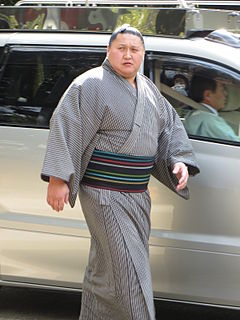 W
WKyokutenhō Masaru in Nalaikh, Ulan Bator, Mongolia is a former professional sumo wrestler. He fought out of Ōshima stable, with the first group of Mongolians ever to join the sport in Japan.
 W
WMaedagawa Katsu was a sumo wrestler from Esashi, Iwate, Japan. He made his professional debut in September 1952, and reached the top division in November 1960. His highest rank was sekiwake. He retired from active competition in May 1967.
 W
WMasurao Hiroo is a Japanese former sumo wrestler, born Hiroo Teshima in Itoda, Fukuoka Prefecture. Making his professional debut in 1979, he reached the top division in 1985. His highest rank was sekiwake and he won five special prizes in his top division career. He was one of the lightest wrestlers in the top division, and very popular with tournament crowds. In his later career he suffered from a number of injuries, particularly to his knee, and he retired in 1990 at the age of 29. He was the head coach of Ōnomatsu stable and a director of the Japan Sumo Association until 2019 when he left for health reasons.
 W
WMeisei Chikara is a Japanese professional sumo wrestler from Setouchi, Kagoshima. He debuted in sumo wrestling in July 2011 and made his makuuchi debut in July 2018. His highest rank has been sekiwake. He wrestles for Tatsunami stable. Unusually for a top-class sumo wrestler, he uses his given name as his shikona.
 W
WMitoizumi Masayuki is a former sumo wrestler from Mito, Ibaraki, Japan. His professional career spanned 22 years, from 1978 until 2000. The highest rank he reached was sekiwake. He won over 800 career bouts and took the yūshō or championship in the top makuuchi division in 1992. Mitoizumi was nicknamed the "Salt Shaker", due to his habit of throwing enormous quantities of purifying salt onto the ring (dohyō) during the pre-match preliminaries. He is now a coach, and is known as Nishikido Oyakata.
 W
WMiyagino Nishikinosuke was a Japanese sumo wrestler. His highest rank was sekiwake. He was an active top makuuchi division wrestler at the age of 52, which is the all-time recognized record.
 W
WMyōbudani Kiyoshi is a former sumo wrestler from Akan, Hokkaidō, Japan. He was a member of Miyagino stable. His highest rank was sekiwake and he twice took part in playoffs for the top makuuchi division tournament championship or yūshō. He was also a runner-up in two other tournaments. He earned eight sanshō or special prizes for his achievements in tournaments, four for Outstanding Performance and four for Fighting Spirit. He also earned three kinboshi or gold stars for defeating yokozuna. After his retirement in 1969 he was an elder of the Japan Sumo Association but left the sumo world in 1977 to become a Jehovah's Witness.
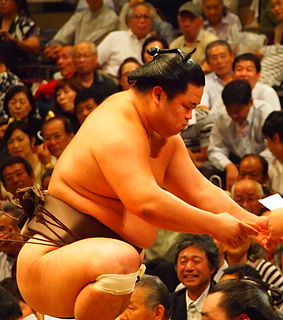 W
WMyōgiryū Yasunari is a Japanese professional sumo wrestler from Takasago, Hyōgo. Making his debut in May 2009 as a makushita tsukedashi out of university, he reached the top division for the first time in November 2011. His highest rank to date has been sekiwake. He has earned six special prizes for Technique and six kinboshi for defeating yokozuna. He was runner-up in the September 2021 tournament.
 W
WOginohana Masaaki was a sumo wrestler from Ogi, Saga, Japan. He made his professional debut in 1952 and reached the top makuuchi division in 1957. His highest rank was sekiwake. He retired in 1967 and worked as a coach at Dewanoumi stable before leaving the Sumo Association in 2000 upon reaching the mandatory retirement age of 65. He was the father of Oginohana Akikazu and Oginishiki Yasutoshi, both successful sumo wrestlers themselves.
 W
WOkinoumi Ayumi is a Japanese professional sumo wrestler from Okinoshima, Shimane. He joined professional sumo in 2005, reaching the top division in 2010. He has been runner-up three times in January 2011, March 2013, and November 2017 tournaments all with an 11–4 record. His highest rank has been sekiwake, which he held for one tournament in March 2015 and then held again in November 2016. He has won four Fighting Spirit prizes to date, one for Outstanding Performance, and four gold stars for defeating yokozuna. He wrestles for Hakkaku stable.
 W
WMitsuhiro Momota , better known as Rikidōzan (力道山), was a Korean-Japanese wrestler who competed in professional wrestling and sumo wrestling. He was known as The Father of Puroresu, and one of the most influential men in professional wrestling history. Initially, he had moved from his native country Korea to Japan to become a sumo wrestler. He was credited with bringing the sport of professional wrestling to Japan at a time when the Japanese needed a local hero to emulate and was lauded as a national hero. He was inducted into the WWE Hall of Fame in 2017, becoming the first Korean inductee and the third puroresu star to be inducted after Antonio Inoki and Tatsumi Fujinami. He was killed in a street fight with a member of the Yakuza in 1963.
 W
WRyōgoku Kajinosuke II was a Japanese sumo wrestler. His highest rank was sekiwake.
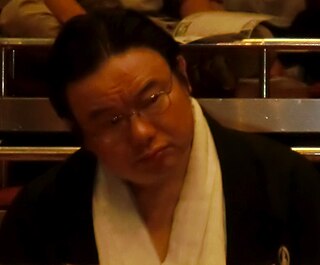 W
WSakahoko Nobushige was a Japanese sumo wrestler. The son of Tsurugamine, he made his professional debut in 1978, reaching the top makuuchi division in 1982. His highest rank was sekiwake. He won nine special prizes and seven gold stars for defeating yokozuna. He retired in 1992 and became the head coach of Izutsu stable in 1994, succeeding his father. He oversaw Kakuryū's promotion to the yokozuna rank in 2014 but also saw the size of his stable decline. He was a deputy director of the Japan Sumo Association and a judge of tournament bouts. He died of pancreatic cancer in 2019. He was the elder brother of fellow top division sumo wrestler Terao Tsunefumi.
 W
WHaguroyama Sojō, born as Osamu Annen was a Japanese sumo wrestler from Hokkaidō.
 W
WTakamiyama Torinosuke was a Japanese sumo wrestler.
 W
WTakanoshō Nobuaki is a Japanese professional sumo wrestler from Kashiwa, Chiba. He made his professional debut in March 2010, reaching the top makuuchi division in September 2018. His highest rank has been sekiwake. He has been a runner-up in one tournament and has two Fighting Spirit prizes. He wrestles for Tokiwayama stable.
 W
WTakanowaka Yūki is a former sumo wrestler from Ikitsuki, Nagasaki, Japan. His highest rank was sekiwake.
 W
WTakarafuji Daisuke is a Japanese professional sumo wrestler from Nakadomari, Aomori. He is a sandanme division champion. The highest rank he has reached is sekiwake.
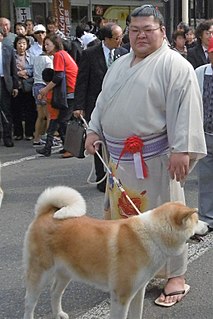 W
WTakekaze Akira is a former professional sumo wrestler from Akita Prefecture, Japan. A former amateur sumo champion, he turned professional in 2002, reaching the top makuuchi division the following year. He was a runner-up in one tournament, earned two special prizes for Fighting Spirit, and one gold star for defeating a yokozuna. Takekaze is in first place for the slowest promotion from makuuchi debut to the third highest sekiwake rank in history. Aged 35 years and 2 months, he is in first place for the eldest to make his sekiwake debut post World War II. He was a member of Oguruma stable. He retired in January 2019 to become an elder of the Japan Sumo Association under the name Oshiogawa Oyakata.
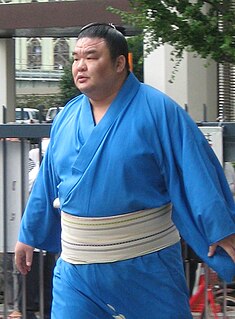 W
WTamakasuga Ryōji is a former sumo wrestler from Seiyo, Ehime Prefecture, Japan. A former amateur sumo champion, he made his professional debut in 1994 and reached a highest rank of sekiwake in 1997. He fought in the top makuuchi division for twelve years, won five special prizes and earned seven gold stars for defeating yokozuna. He retired in 2008 and is now a sumo coach. In February 2010 he took over the running of Kataonami stable.
 W
WTamanoshima Arata is a former sumo wrestler from Izumizaki, Fukushima, Japan. A former amateur champion, he made his professional debut in 1998, reaching the top makuuchi division at the end of 2000. He was twice runner-up in a tournament, and earned six special prizes and two gold stars during his career. His highest rank was sekiwake. He wrestled for Kataonami stable. He retired in November 2011 to become an elder of the Japan Sumo Association and is now known as Hanaregoma Oyakata. In December 2021 he became head coach of Hanaregoma stable.
 W
WTamanoumi Daitarō was a sumo wrestler from Ōita, Japan. His highest rank was sekiwake. He won a top division tournament championship in 1957. He was later the head coach of Kataonami stable.
 W
WTamatsubaki Kentarō was a sumo wrestler from Toyama City, Japan. He was known for his techniques, which accommodated his small size. Although his height was only 158 cm, he gave the likes of Hitachiyama and others a real challenge and was called the "mite". He was the shortest wrestler in sumo history, and also one of the lightest at 73 kg. His highest rank was sekiwake. After retirement he was known as Shiratama-oyakata.
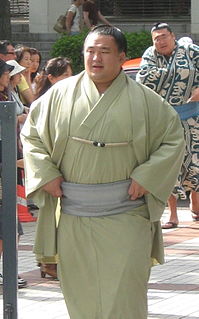 W
WTamawashi Ichirō is a Mongolian professional sumo wrestler from Ulaanbaatar. He made his debut in January 2004 and reached the top makuuchi division in September 2008. His highest rank has been sekiwake. He has a makushita, a jūryō and a makuuchi division championship. He has four gold stars for defeating a yokozuna, and three special prizes. He wrestles for Kataonami stable. He has not missed a bout in his career to date and has the longest streak of consecutive matches among active wrestlers. In January 2019, he won his first top-division championship at the age of 34.
 W
WTerao Tsunefumi is a Japanese former sumo wrestler. He was born in Tokyo, but brought up in Kajiki, Aira District, Kagoshima, Japan. He fought out of Izutsu stable. The highest rank he reached was sekiwake. Despite his relatively light weight he had an extremely long career, spanning 23 years from 1979 until 2002, and was known as the "iron man" of sumo. He is now the head coach of Shikoroyama stable.
 W
WTochinonada Taiichi is a former sumo wrestler from Ishikawa Prefecture, Japan. An amateur sumo champion, he turned professional in 1996 and reached the top makuuchi division in 1997. He earned twelve kinboshi or gold stars for defeating yokozuna, the second highest ever, and he was a runner-up in two tournaments. His highest rank was sekiwake. He is now a coach at Kasugano stable under the name Takenawa Oyakata.
 W
WTochinowaka Kiyotaka is a former sumo wrestler from Wakayama Prefecture, Japan. A former amateur champion, he turned professional in 1985, reaching the top makuuchi division in 1987. His highest rank was sekiwake. He was a runner-up in one tournament and earned six special prizes and four kinboshi. After 76 tournaments and 1114 bouts in the top division he retired in 1999. He is now an elder of the Japan Sumo Association and the head coach of Kasugano stable.
 W
WTochiōzan Yūichirō is a Japanese former professional sumo wrestler from Aki, Kōchi. He made his professional debut in January 2005 and reached the top makuuchi division in March 2007, retiring in July 2020. At one point he was regarded as one of the most promising Japanese rikishi. His highest rank was sekiwake. His best performance came in May 2012 when he tied with Kyokutenhō after fifteen days but was beaten in a play-off. He earned six special prizes for his achievements in tournaments and six gold stars for defeating yokozuna. He made twenty-five appearances in the san'yaku ranks.
 W
WTokitsuyama Jin'ichi was a professional sumo wrestler from Iwaki, Fukushima, Japan who wrestled for Tatsunami stable. He won the top division sumo championship in the summer tournament of 1953 and was runner-up in five other tournaments. His highest rank was sekiwake. After his retirement in 1961 he worked as a coach at Tatsunami stable until his death in 1968.
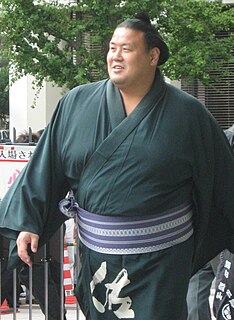 W
WTosanoumi Toshio, is a former sumo wrestler. He first reached the top division of professional sumo in 1995, winning 13 special prizes and earning 11 kinboshi or gold stars for defeating yokozuna over his long career. The highest rank he reached was sekiwake. He retired in 2010 to become a coach at his stable, Isenoumi stable under the name of Tatekawa.
 W
WToyonoshima Daiki is a former professional sumo wrestler from Sukumo, Kōchi, Japan. He made his professional debut in January 2002, reaching the top makuuchi division in September 2004. He was a runner-up in five tournaments, and earned ten special prizes. His highest rank was sekiwake, which he first reached in September 2008 and held for five tournaments in total. Following a suspension in July 2010 he was demoted to the jūryō division, but upon his return to makuuchi in November 2010 he took part in a playoff for the championship. He won four kinboshi or gold stars awarded for yokozuna upsets, three of them earned by defeating Harumafuji from 2013 to 2015. He wrestled for Tokitsukaze stable. He retired in 2020 and is now an elder of the Japan Sumo Association under the name of Izutsu Oyakata.
 W
WTsurugamine Akio, real name Akio Fukuzono, was a sumo wrestler from Aira, Kagoshima, Japan. His highest rank was sekiwake. He was twice runner-up in a tournament and won 14 special prizes, including a record ten for Technique, and earned ten gold stars for defeating yokozuna. After his retirement he was the head of Izutsu stable and coached two of his sons, Sakahoko and Terao, to the top division.
 W
WWakachichibu Komei was a sumo wrestler from Chichibu, Saitama, Japan. He made his professional debut in May 1954 and reached the top division in September 1958. His highest rank was sekiwake. Upon retirement from active competition he became an elder in the Japan Sumo Association, under the name Tokiwayama. He reached the Sumo Association's mandatory retirement age in March 2004.
 W
WWakamisugi Akiteru, also known as Daigō Hisateru, was a sumo wrestler from Kagawa, Japan. The highest rank he achieved was sekiwake. He was the brother in law of yokozuna Wakanohana Kanji I.
 W
WWakanosato Shinobu is a retired sumo wrestler from Hirosaki, Aomori, Japan. He made his debut in the top division in 1998, and his highest rank was sekiwake. He holds the record for the most consecutive tournaments ranked in the junior san'yaku ranks of sekiwake and komusubi. He won ten special prizes and was twice runner-up in a tournament. He earned two gold stars for defeating yokozuna at a maegashira rank. He had 1691 career bouts, sixth on the all-time list. He retired in 2015 and was a coach at Tagonoura stable, until opening his own Nishiiwa stable in February 2018.
 W
WYoshikaze Masatsugu is a former sumo wrestler from Saiki, Oita Prefecture, Japan. His highest rank was sekiwake. A former amateur sumo champion, he turned professional in 2004, reaching the top division two years later. Until his promotion to komusubi in May 2014 he had the active record for the longest serving makuuchi wrestler who had never reached a titled rank. His best performance in a tournament came in July 2015 when he was the runner-up and scored twelve wins against three losses. In the following tournament in September 2015 he defeated two yokozuna and won special prizes for Outstanding Performance and Technique. Yoshikaze is in second place for the slowest promotion from makuuchi debut to the third highest sekiwake rank in history, behind only his stablemate Takekaze. He won ten special prizes in total, and eight gold stars for defeating yokozuna. He retired in September 2019 and is now an elder of the Japan Sumo Association, known as Nakamura Oyakata.